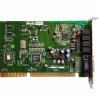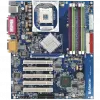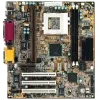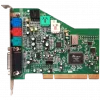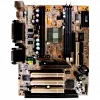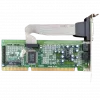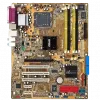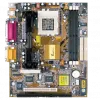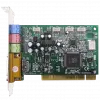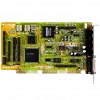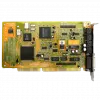The game port, originally introduced on the Game Control Adapter, is a device port that was found on IBM PC compatible and other computer systems throughout the 1980s and 1990s. It was the traditional connector for joystick input, and occasionally MIDI devices, until replaced by USB in the 21st century.
Originally located on a dedicated expansion card, the game port was later integrated with PC sound cards, and still later on the PC's motherboard. During the transition to USB, many input devices used the game port and a USB adaptor in the form of a cable expansion.
The game port first appeared during the initial launch of the original IBM PC in 1981, in the form of an optional US$55 expansion card known as the Game Control Adapter. The design allowed for four analog axes and four buttons on one port, allowing two joysticks or four paddles to be connected via a special "Y-splitter" cable.
At the time there was no sort of industry standard for controller ports, although the closest was the Atari joystick port. This was originally introduced in 1977, on the Atari VCS, and by 1981, was used on both Atari gear and the Commodore VIC-20. But it could not be considered truly widespread until around 1983, when it appeared on the Commodore 64 and several other platforms. In contrast with the IBM design, the Atari port was primarily designed for digital inputs, specifically eight-direction joysticks. It did include two analog inputs as well, which could support a single analog joystick, but these were not widely used. The Apple II also sported a joystick port with enough channels for two joysticks, but only one button per stick. The BBC Micro had a similar port to the IBM design, even using the same 15-pin connector, but was wired in such a way to support only one fire button per stick. In most respects, the IBM design was similar or more advanced than existing designs.
Originally available only as add-on that took up an entire slot, game ports remained relatively rare in the early days of the IBM PC, and most games used the keyboard as an input. IBM did not release a joystick of its own for the PC, which did not help. The most common device available was the Kraft joystick, originally developed for the Apple II but easily adapted to the IBM with the addition of another button on the back of the case. When IBM finally did release a joystick, for the IBM PCjr, it was a version of the Kraft stick. However, it connected to the computer using two incompatible 7-pin connectors, which were mechanically connected together as part of a larger multi-pin connector on the back of the machine. This eliminated the need for the Y-adaptor. Adaptors for Atari-style "digital" sticks were also common during this era.
The game port became somewhat more common in the mid-1980s, as improving electronic density began to produce expansion cards with ever-increasing functionality. By 1983, it was common to see cards combining memory, game ports, serial and parallel ports and a realtime clock on a single expansion card. The era of combo expansion cards largely came to an end by the late 1980s, as many of the separate functions normally provided on plug-in boards became common features of the motherboard itself. Game ports were not always part of this supported set of ports.
However, the game port was given a major boost in usage in 1989, with the introduction of the first Sound Blaster. As sound cards were primarily used with computer games, Creative Labs took the opportunity to include a game port on the card, producing an all-in-one gaming solution. At the same time, they re-purposed two otherwise redundant pins on the port, 12 and 15, to produce a serial bus with enough performance to drive an external MIDI port adaptor. Previous MIDI systems like the MPU-401 used their own separate expansion cards and a complex external adaptor, whereas the Sound Blaster only required an inexpensive adaptor to produce the same result. By the end of the year the Sound Blaster was the best selling expansion card on the PC, and was almost universal on new machines, and the game port was finally widespread.
With the exception of laptops—for which companies released joystick adapters for parallel or serial ports, which needed custom software drivers—through the early 1990s, the game port was universally supported on sound cards, and increasing became built-in features as motherboards added sound support of their own. This remained true through the second half of the 1990s, by which time integrated sound support had displaced the 3rd party sound card to a large degree. By the early 2000s, such support was so widespread that newer sound cards began to dispense with the game port as it was certain the machine they would be used in already had such support, including MIDI.
The introduction of the first USB standard in 1996, was aimed squarely at the sort of roles provided by the game port, but initially had little market impact. The introduction of the iMac, which was based almost entirely on USB expansion, began a rapid expansion of USB in the market. This led both to new gaming devices using USB, as well as the profusion of adaptors. For instance, the 1997 Microsoft Precision Pro joystick was re-introduced in a version that used a game port connector, but also included a USB adaptor in the box. The rapid takeover of USB meant that this was superfluous when the Precision Pro 2 was released the next year in 1998. By 2000, game ports were purely for backward compatibility with now outdated devices.
Microsoft Windows discontinued support for the game port with Windows Vista, though USB converters can serve as a workaround.
